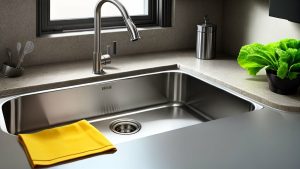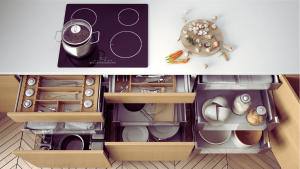If you’re after a home that’s both as tidy as a new pin and as hearty as an ox, keeping your kitchen sink clear of any gunk and free from funky odors is vital. But with daily use, it’s easy for food scraps, grease, and other debris to build up in your drain over time. Fortunately, there are simple tips and practices you can implement to keep your kitchen drain spick and span.
Key Takeaways:
- Regular kitchen drain maintenance can prevent clogs, odours, and costly repairs.
- Common causes of kitchen drain clogs include food scraps, grease buildup, soap residue, and foreign objects.
- Best practices for kitchen drain maintenance include pouring boiling water down the drain, using a drain strainer, and avoiding pouring grease down the sink.
- Trusty home solutions, such as a sprinkle of baking soda and a dollop of vinegar, can help banish those unpleasant smells, while a bit of DIY magic can sort out those little snags.
- Professional help may be needed for complex problems or recurring issues.
Importance of a Clean Kitchen Drain
A clean kitchen drain is essential for the smooth functioning of your kitchen. Clogged drains can cause backups, leading to unpleasant odors and, in severe cases, costly repairs. As per a piece of research conducted by the Environmental Protection Agency (EPA), clogged drains are one of the most common household issues. Keeping up with the routine upkeep and giving it a good scrub now and then can help keep those pesky blockages, odors, and potential health hazards at bay.
Preventing clogs is one of the most significant benefits of maintaining a clean kitchen drain. Blockages in the gutter can cause water to back up, leading to slow or standing water, and food particles can accumulate, resulting in unpleasant odors. In addition, clogs can cause damage to your plumbing system, leading to expensive repairs or replacements.
Giving your kitchen drain a regular sprucing up can lend a hand and prevent the accumulation of food particles and debris, reducing the likelihood of clogs. It can also help prevent foul odors from emitting from the drain, improving kitchen hygiene.
Common Causes of Kitchen Drain Clogs
A variety of factors can cause kitchen drain clogs. Knowing what to look out for can help in warding off the buildup of those pesky food bits and random gunk; here are some common culprits:
| Cause | Preventive Measures |
|---|---|
| Food scraps | Scrape plates and bowls into the trash before washing. Grab a drain strainer to snag any leftovers or food particles. |
| Grease buildup | Avoid pouring cooking oil or grease heading down the drain. Instead, let it chill out and then chuck it in the bin. |
| Soap residue | Use a drain strainer to prevent soap scum from entering the sinkhole. Make it a habit to occasionally send a stream of hot water down the drain. Flush away any buildup. |
| Foreign objects | Make sure only water and small food particles go down the drain. Keep items like silverware, straws, and plastic wrappers away from the sink to avoid accidental drops. |
By taking these preventive measures, you can help avoid kitchen drain clogs and save yourself from the hassle of dealing with a blocked drain.
Best Practices for Kitchen Drain Maintenance
Maintaining a clean kitchen drain may seem daunting, but with proper maintenance, it can be a breeze. Here are some best practices to keep your kitchen drain spick and span:
- Run hot water down the drain regularly. Hot water helps dissolve and flush away grease, oils, and soap buildup.
- Use a drain strainer to catch food scraps and other debris that can cause blockages. Empty the filter after each use and clean it regularly.
- Avoid pouring grease down the drain. Oil solidifies as it cools down, leading to blockages. Instead, let it cool and dispose of it in the trash.
- Flush the drain with baking soda and vinegar regularly. This natural remedy helps combat odors and dissolves minor blockages.
- Deep clean the drain with an enzymatic or bacterial drain cleaner once a month. These cleaners break down organic materials that can cause clogs.
- Don’t use chemical drain cleaners. They can damage your pipes and do more harm than good.
- Consider investing in a garbage disposal unit. This device can chop up food scraps, making them more manageable for your drain.
By following these best practices, you can maintain a clean kitchen drain and prevent clogs and costly repairs.
Preventing Foul Odors from Your Kitchen Drain
A stinky kitchen drain can be a real nuisance in any household. Luckily, several ways exist to eliminate unpleasant odors and keep your drain smelling fresh. Here are some tips:
Using Natural Remedies
Baking soda and vinegar are natural ingredients that can help eliminate kitchen drain odors. Start by pouring half a cup of baking soda down the drain, followed by half a cup of vinegar. Cover the drain and let the mixture sit for at least 30 minutes. Then, pour a pot of boiling water down the drain to rinse any remaining residue. Alternatively, you can freshen up your gutter with lemon juice or essential oils.
Using Commercial Drain Cleaners
If natural remedies do not work, use commercial drain cleaners. However, choose a product specifically designed for kitchen drains and follow the instructions carefully. Some drain cleaners can be harsh and may damage your pipes if misused.
Preventing Odors in the First Place
The best way to prevent foul odors from your kitchen drain is to maintain your drain and avoid clogs regularly. Follow the tips in this article, such as using a drain strainer and avoiding pouring grease down the sink. Also, be mindful of what you put down your drain and avoid disposing of food waste or other debris in the sink.
Unclogging a Kitchen Drain
A clogged drain can be a significant headache, but there are several methods you can use to unclog your kitchen drain. The best way to unclog a drain will depend on the severity of the blockage.
Method 1: Plunger
The plunger is a household tool that can help dislodge minor blockages in your kitchen drain. To use a plunger, first place it over the drain and add a small amount of water to create suction. Next, use the plunger up-and-down to create pressure to help release the blockage. Repeat as necessary until the water drains smoothly.
Method 2: Drain Snake
A drain snake can remove blockages that a plunger can’t reach. To use a drain snake, insert the snake into the drain and turn the handle to extend the snake more profound into the gutter. Once you feel resistance, turn the handle in the opposite direction to help break up the blockage. If the blockage is too severe for the snake, it may be time to call a professional plumber.
Method 3: Baking Soda and Vinegar
A mixture of baking soda and vinegar can create a chemical reaction that can help dissolve minor clogs:
- Pour a pot of boiling water down the drain to help loosen debris.
- Pour a cup of baking soda down the drain and let it sit for a few minutes.
- Pour a cup of vinegar down the drain.
Cover the drain with a plug or towel to contain the fizzing reaction, and let it sit for at least 30 minutes. Finish by flushing the drain with hot water to clear any remaining debris.
Always be cautious when unclogging a drain to avoid causing damage or injury. If the blockage is severe or persists despite your efforts, it’s time to call in a licensed plumber.
Regular Kitchen Drain Cleaning Routine
Establishing a regular cleaning routine prevents kitchen drain clogs and maintains a clean drain.
Here are some tips for maintaining a regular cleaning routine:
- Daily cleaning: Dispose of food scraps properly and wipe down the drain with a clean cloth or sponge after each use.
- Weekly cleaning: Use a drain strainer to catch any debris and clean it thoroughly. Pour boiling water down the drain to dissolve any grease buildup.
- Monthly cleaning: Use a commercial drain cleaner or a mixture of baking soda and vinegar to deep clean the drain. Let the solution sit for about 15 minutes before flushing it with hot water.
These simple steps can help prevent clogs and extend the life of your kitchen drain.
Signs You Need Professional Help
While regular maintenance can prevent most kitchen drain issues, a professional’s assistance is sometimes needed. Here are a few signs that indicate it’s time to call in an expert:
- Your drain keeps getting clogged, even after trying different DIY solutions.
- There is standing water in the sink that won’t drain.
- You notice foul smells coming from the drain.
- You hear gurgling or other strange noises coming from the drain.
If you’re experiencing any of these issues, it’s best to contact a licensed plumber for assistance. They have the tools and expertise to handle complex problems and identify underlying issues that may require professional repairs. Ignoring these signs could lead to more severe blockages or damage to your plumbing system, resulting in costly repairs.
Safety First!
Before attempting any troubleshooting on a clogged drain, make sure to follow proper safety precautions. Always wear protective clothing, gloves, and eyewear when using chemical drain cleaners or tools like drain snakes. If using a plunger, make sure to create a tight seal to prevent water and debris from splashing back onto you.
Preventive Measures for Long-Term Kitchen Drain Maintenance
Regular maintenance is essential to keep your kitchen drain clean and prevent clogs from forming. However, you can also take preventive measures to ensure the long-term health of your drain.
| Preventive Measures | Explanation |
|---|---|
| Regular Inspections | Periodically inspect your kitchen drain to catch any buildup or damage before it becomes a larger issue. |
| Avoid Chemical Drain Cleaners | Chemical drain cleaners can corrode pipes, damage your plumbing system, and harm the environment. Opt for natural remedies or seek professional help for stubborn clogs. |
| Educate Family Members | Teach your family members proper disposal practices, such as not pouring grease down the drain or throwing food scraps in the sink. |
| Maintain Overall Kitchen Cleanliness | A clean kitchen reduces the debris that can enter your drain and cause clogs. Wipe down counters, sweep floors, and regularly dispose of trash to maintain a clean environment. |
By following these preventative measures, you can ensure the long-term health of your kitchen drain, saving you from costly repairs and the inconvenience of clogs and odors.
DIY Solutions for Minor Kitchen Drain Issues
Minor clogs in the kitchen drain can be frustrating, but you can try some easy DIY solutions before calling in a professional. Remember that a licensed plumber should address major blockages or complex issues.
Baking Soda and Vinegar Method
This natural remedy can be very effective in loosening minor clogs. Start by pouring a pot of boiling water down the drain to help remove any loose debris. Then, pour ½ cup of baking soda down the drain, followed by 1 cup of vinegar. Quickly cover the drain with a plug or a towel to prevent the mixture from bubbling. Let the mixture sit for 30 minutes before flushing the drain with hot water.
Plunger Method
A plunger can work wonders in unclogging a kitchen drain. Make sure you have a good seal around the drain with the plunger, and plunge up and down vigorously for about a minute. Check if the water is draining more freely. If it’s not, try falling again until the clog is removed.
Manual Removal of Debris Method
If the clog is visible, you can try manually removing it. To do this:
- Use a pair of gloves and a flashlight.
- Remove any visible debris within reach with your hands or a pair of pliers.
- Be careful not to damage the drain or push the debris further down.
Remember, these are temporary fixes for minor issues. A regular cleaning routine and preventive measures can help avoid clogs and maintain a clean kitchen drain.
The Benefits of a Clean Kitchen Drain
Keeping your kitchen drain clean doesn’t just prevent clogs and odors – it also has numerous benefits for your health and well-being. Here are some of the advantages of maintaining a clean kitchen drain:
- Better hygiene: A dirty kitchen drain can harbor bacteria and other harmful microorganisms, contaminating your food and kitchen surfaces. Keeping your drain clean can help prevent the spread of germs and ensure your kitchen is safe and hygienic.
- Reduced risk of water damage: Clogs and blockages in your kitchen drain can cause water to back up and overflow, resulting in water damage to your floors, cabinets, and countertops. Maintaining a clean drain can reduce the risk of these incidents.
- Increase the lifespan of your drain: Regular maintenance can help prolong the lifespan of your kitchen drain. By removing debris and buildup, you can help prevent corrosion, rusting, and other damage that can compromise the function of your drain.
- Improved kitchen smell: Foul odors from your kitchen drain can be unpleasant and make cooking and entertaining difficult. Keeping your drain clean and odor-free allows you to enjoy a more pleasant and inviting kitchen environment.
Troubleshooting and Maintenance Tips for Different Kitchen Drain Types
Not all kitchen drains are created equal, and various materials require different maintenance and care. Here are some troubleshooting and maintenance tips for different types of kitchen drains:
Stainless Steel Drains
Stainless steel drains are common in modern kitchens due to their durability and sleek look. However, they are prone to scratches and need regular cleaning to maintain their shiny appearance.
| Tip | Description |
|---|---|
| Clean with gentle soap and hot water | Avoid using harsh chemicals and abrasive cleaners that can damage the finish of the stainless steel. Instead, use mild soap and hot water to wipe down the drain. |
| Remove scratches with baking soda. | Mix baking soda with water to form a paste if your drain has minor scratches. Apply the mixture to the scratch with a soft cloth and rub gently until the scratch is less visible. |
| Protect from hard water stains. | Install a water softening system or use vinegar and water to prevent hard water stains from building up on the drain. |
Ceramic Drains
Ceramic drains are popular for traditional and farmhouse-style kitchens due to their timeless design and various colors and patterns.
| Tip | Description |
|---|---|
| Clean regularly with mild soap and water | Ceramic drains can be cleaned easily with mild soap and water. Use a soft cloth to wipe down the surface and remove any debris. |
| Avoid harsh chemicals and abrasive cleaners | Do not use harsh chemicals or abrasive cleaners that can damage the surface of the ceramic. Opt for natural cleaning solutions like vinegar and water. |
| Prevent discoloration | Use a drain strainer to prevent food particles from staining the ceramic. If discoloration occurs, try mixing baking soda and water to remove stains. |
Plastic Drains
Plastic drains are cost-effective for many kitchens and easy to install and replace. However, they are more prone to scratches and warping than other materials.
| Tip | Description |
|---|---|
| Clean with mild dish soap and hot water | Avoid abrasive cleaners and use mild dish soap and hot water to clean plastic drains. Scrub gently with a soft cloth to remove any debris. |
| Avoid hot liquids and heavy objects | Plastic drains can warp easily, so avoid pouring hot liquids down the drain and placing heavy objects on top of it. |
| Replace if showing signs of wear and tear | If your plastic drain shows any signs of wear and tear, like cracks or discoloration, consider a replacement. Replace it. |
By following these tips, you can ensure your kitchen drain stays in top condition, regardless of the material it is made of.
Conclusion
Keeping your kitchen drain clean may seem small, but it prevents costly repairs, foul odors, and health hazards. Following the tips outlined in this article, you can create a regular cleaning routine and establish preventive measures for long-term maintenance.
Remember to be mindful of what you put down the drain and avoid common culprits like grease, food scraps, and foreign objects. Utilize natural remedies like vinegar and baking soda to eliminate odors, and consider seeking professional help for more complex issues.
A clean kitchen drain promotes hygiene and cleanliness and saves you money in the long run. Adopting best practices for maintenance and troubleshooting can help you avoid emergencies and keep your kitchen running smoothly.
Implement these tips today and enjoy the benefits of a spick and span kitchen drain!
FAQ
Q: How often should I clean my kitchen drain?
A: It is recommended to clean your kitchen drain regularly to prevent clogs and maintain cleanliness. A weekly cleaning routine is advisable, with additional deep cleanings as needed.
Q: What are the common causes of kitchen drain clogs?
A: Common causes of kitchen drain clogs include food scraps, grease buildup, soap residue, and foreign objects. Proper disposal practices and regular maintenance can help prevent these blockages.
Q: How can I prevent foul odors from my kitchen drain?
A: To prevent foul odors, use natural remedies like baking soda and vinegar or commercial drain cleaners. Regular cleaning and maintenance of the drain will also help eliminate odors.
Q: How can I unclog a kitchen drain?
A: There are several methods for unclogging a kitchen drain. You can use a plunger, a drain snake, or a mixture of hot water and baking soda. For more severe blockages, it may be necessary to seek professional help.
Q: When should I seek professional help for my kitchen drain?
A: If you experience recurring clogs, slow drainage, or strange noises from your kitchen drain, you should seek professional assistance from a licensed plumber.
Q: What are the benefits of maintaining a clean kitchen drain?
A: Maintaining a clean kitchen drain improves hygiene, reduces the risk of contamination, and provides overall peace of mind. A clean drain also helps prevent clogs and expensive repairs.
Q: How do I troubleshoot and maintain different kitchen drain types?
A: Different kitchen drain types may require specific troubleshooting and maintenance. Stainless steel, ceramic, and plastic drain systems each have unique considerations. Consult the particular guidelines for your drain type.

It’s me, Amber Hayden, the heart and soul behind SagarmathaOnlineMedia.com. From a young age, I’ve been head over heels for everything home-related, from interior decor to gardening. I’m the type who can’t resist a well-crafted piece of furniture, and I firmly believe that a home isn’t complete without a pet or two. But it’s not just about creating pretty spaces for me. I’m all about making homes that tell a story reflecting the people living there. SagarmathaOnlineMedia.com is my way of sharing this passion with you. Whether you’re looking for tips to jazz up your living room, advice on pet care, or ideas to make your garden bloom, I’m here to help. So, let’s embark on this journey together and make your house a home!



